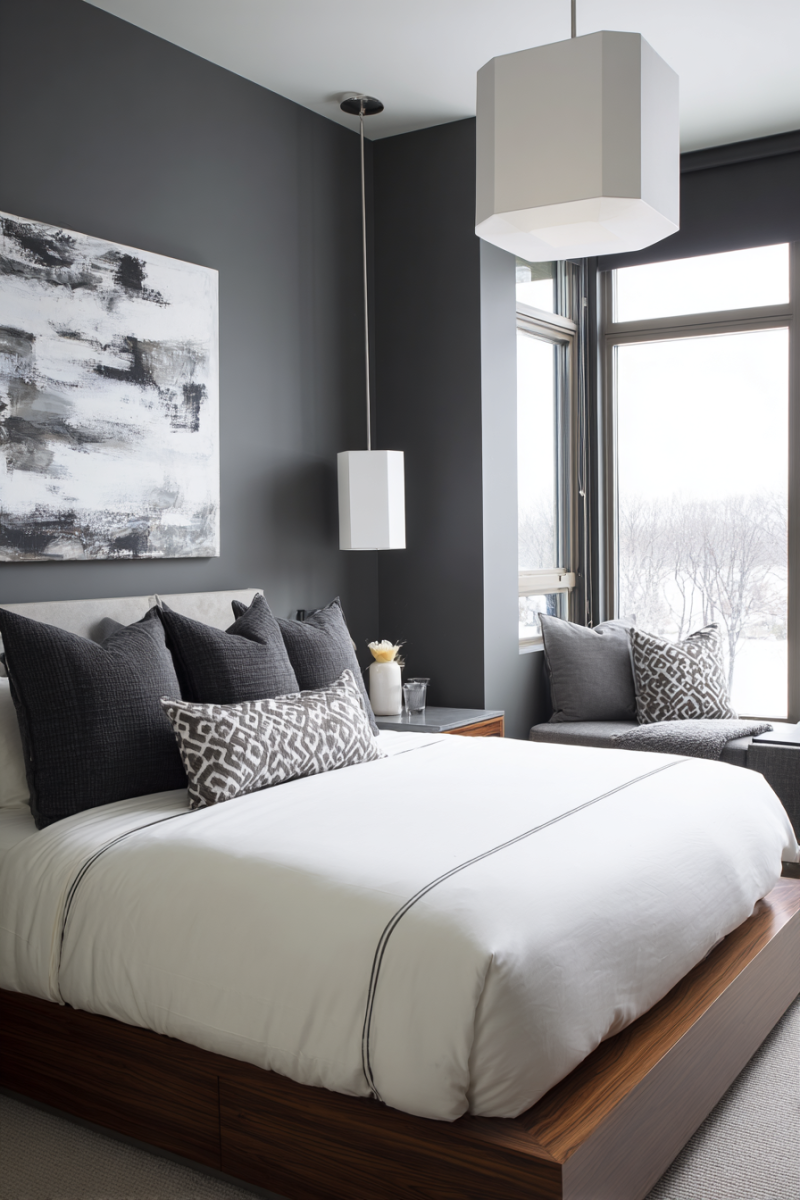There’s something magical about walking into a bedroom that just feels right. The colors wrap around you like a warm embrace, instantly calming your mind after a hectic day. I’ve learned through years of decorating that the secret to this tranquility lies in one crucial decision—choosing the perfect paint color.
Your bedroom isn’t just another room in your home. It’s your personal sanctuary, the place where you start each morning and end every night. The paint color you choose sets the emotional tone for everything that happens within those four walls. Want to wake up energized? Drift off peacefully? Create a romantic atmosphere? It all begins with color.
I’ve carefully curated this list of 15 stunning bedroom paint colors to help you transform your space. From soothing neutrals that promote deep sleep to bold statement shades that showcase your personality, each option offers something unique. These aren’t just trendy colors—they’re timeless choices backed by color psychology and design principles that actually work.
Whether you’re planning a complete bedroom makeover or simply refreshing your space with an accent wall, you’ll find inspiration here. I’ll share practical tips for each color, including the best furniture pairings, complementary accent shades, and styling tricks I’ve discovered along the way. Ready to discover the paint color that will make your bedroom the retreat you’ve always dreamed of? Let’s dive in.
1. Whisper Soft Gray
There’s a reason soft gray continues to dominate bedroom design—it creates instant sophistication without overwhelming your senses. This versatile neutral works beautifully in both modern and traditional spaces, acting as the perfect backdrop for any decor style.
The beauty of soft gray lies in its adaptability. It reflects natural light during the day, making your room feel spacious and airy. At night, it transforms into a cozy cocoon that promotes restful sleep. I recommend pairing it with crisp white trim and warm wood furniture for maximum impact.
Designer tip: Choose a gray with warm undertones to avoid that cold, sterile feeling. Test your paint samples in different lighting throughout the day before committing.
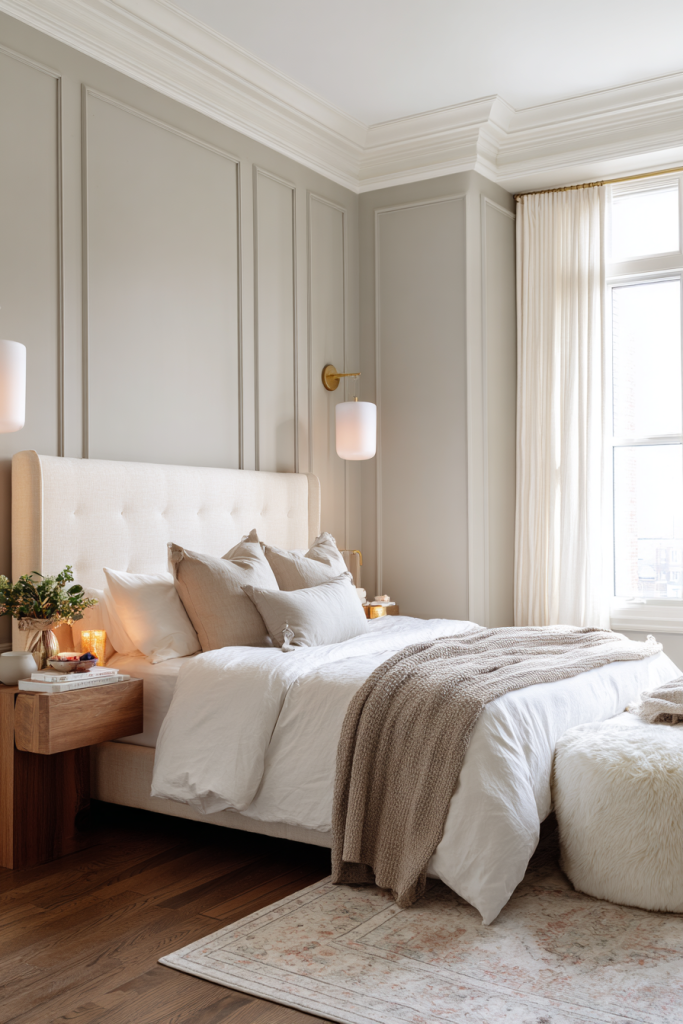
2. Calming Sage Green
Nature-inspired sage green brings the outdoors inside, creating a peaceful retreat that feels both fresh and grounding. This earthy hue has skyrocketed in popularity because it offers the perfect balance between color and neutrality.
Sage green works wonders for promoting relaxation and reducing stress. The subtle green tones connect you to nature, triggering feelings of renewal and tranquility. It pairs beautifully with natural materials like rattan, jute, and light woods, creating an organic, cohesive look.
For a layered approach, add textured throw pillows in cream and terracotta. Consider incorporating plants to amplify the natural vibe—the green walls make your botanical friends pop even more.
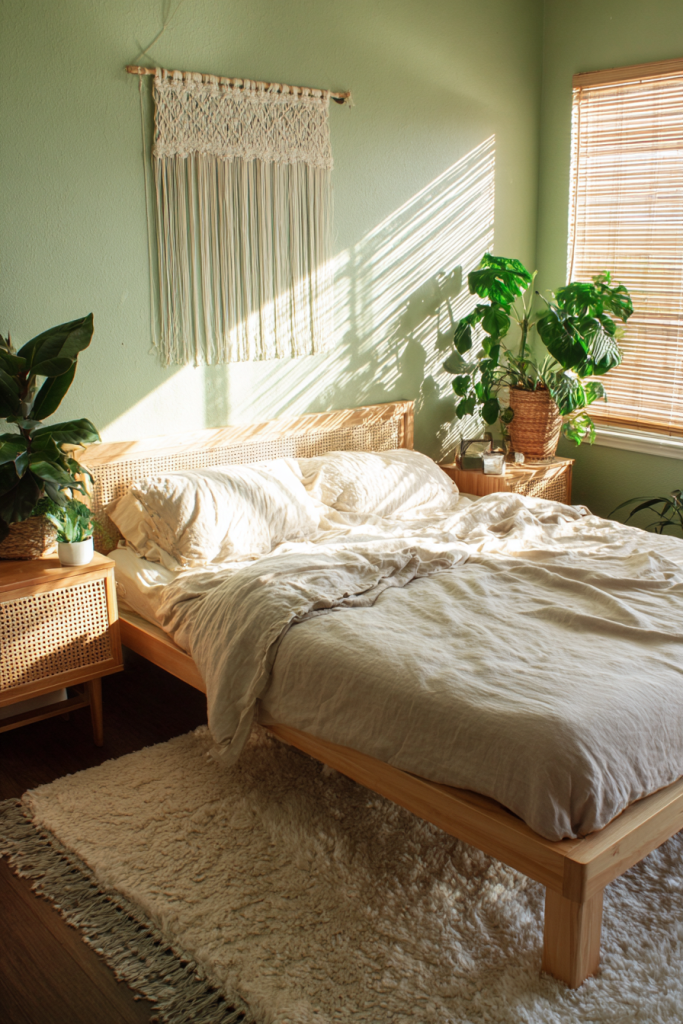
3. Serene Powder Blue
If you crave the feeling of endless summer skies, powder blue delivers that breezy, carefree atmosphere. This gentle hue is scientifically proven to lower blood pressure and heart rate, making it ideal for better sleep quality.
Powder blue creates an airy, expansive feeling, especially in smaller bedrooms. The light-reflecting properties make your space feel larger and more open. I love pairing it with white furniture and natural fiber rugs for a coastal-inspired retreat.
Add warmth with gold or brass hardware and light wood accents. Layer in soft textures through velvet cushions or a chunky knit throw to prevent the room from feeling too cool.
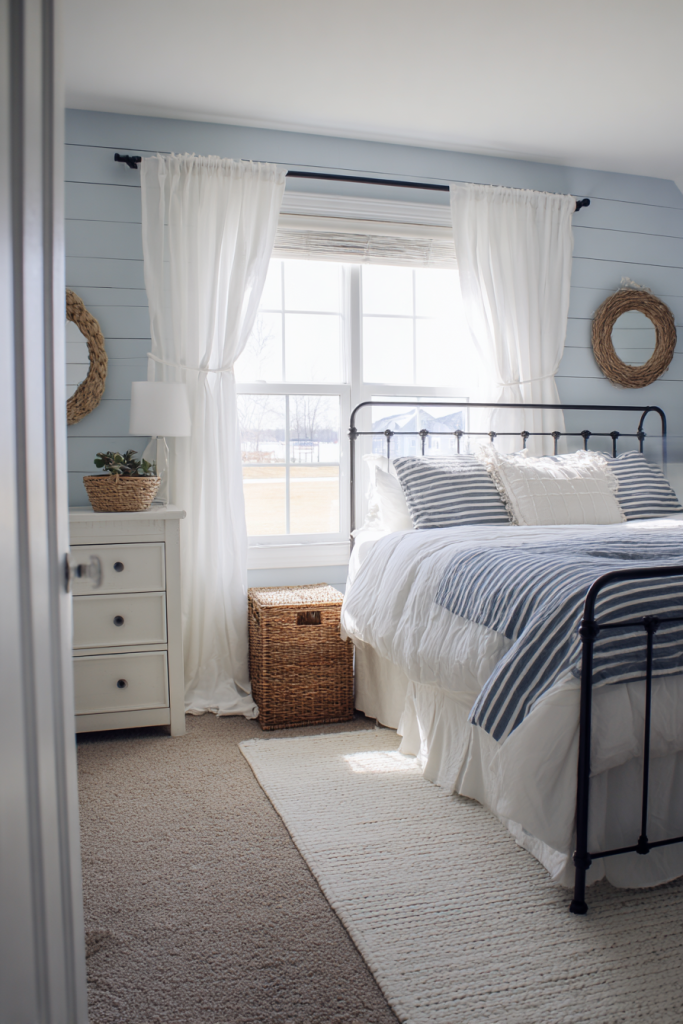
4. Rich Warm Beige
Warm beige wraps your bedroom in comfort, creating an inviting space that feels like a perpetual hug. This timeless neutral has staying power because it works with virtually every design style and color scheme.
The key to making beige work is choosing the right undertone. Look for shades with golden or peachy hints rather than gray undertones. This warmth creates a cozy atmosphere perfect for unwinding after long days.
Beige serves as an excellent foundation for layering textures and patterns. Mix various shades of beige, cream, and tan through bedding, curtains, and rugs. Add depth with chocolate brown or charcoal gray accents.
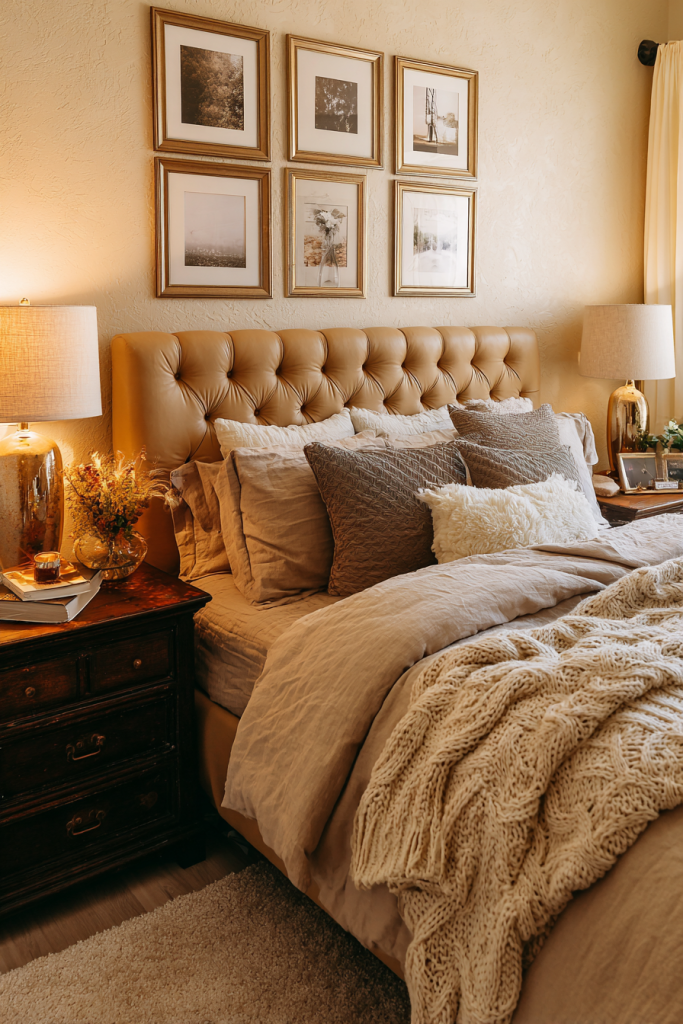
5. Romantic Dusty Rose
Dusty rose offers all the romance of pink without the overwhelming sweetness. This muted, sophisticated shade creates an elegant backdrop that feels grown-up and refined.
The beauty of dusty rose lies in its versatility—it reads as nearly neutral while still providing color interest. It works exceptionally well in bedrooms with vintage or romantic decor styles. The soft pink tones promote feelings of comfort and tenderness.
Balance the femininity by incorporating stronger elements like black metal light fixtures or deep charcoal accents. Pair with gray, cream, or soft gold for a beautifully harmonious palette.

6. Bold Navy Blue
For those who love drama and sophistication, navy blue delivers impact while remaining surprisingly restful. This deep, rich color creates intimacy and depth, transforming your bedroom into a luxurious cocoon.
Navy works particularly well in larger bedrooms where darker colors won’t overwhelm the space. It provides a stunning backdrop for metallic accents—think brass, copper, or gold hardware that pops against the deep blue.
Don’t let the darkness scare you. Navy actually enhances the quality of sleep by creating a cave-like atmosphere. Balance it with plenty of white bedding and light-colored furniture to prevent the space from feeling too heavy.
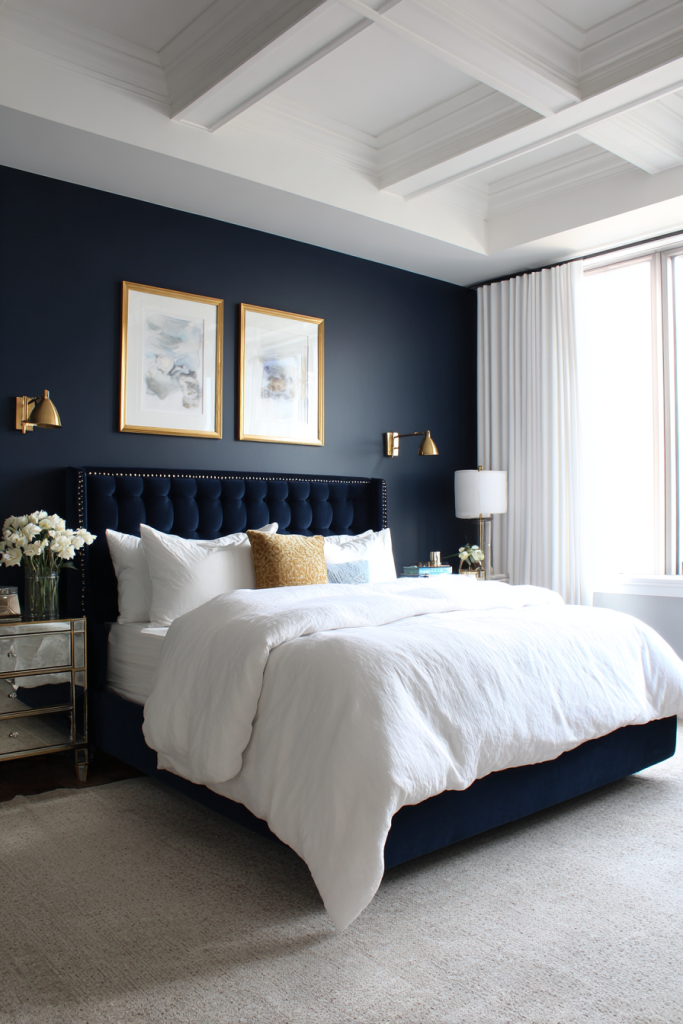
7. Sophisticated Charcoal
Charcoal gray brings urban sophistication to the bedroom, creating a modern sanctuary that feels both bold and calming. This darker neutral has become increasingly popular for its ability to ground a space while maintaining elegance.
The depth of charcoal creates wonderful contrast opportunities. Pair it with crisp whites for a striking monochromatic scheme, or warm it up with caramel leather and natural wood tones. The key is balancing the darkness with plenty of light sources.
Charcoal works beautifully in contemporary spaces but can also complement industrial or minimalist designs. Layer various gray tones through textiles and decor to add dimension and prevent the space from feeling flat.
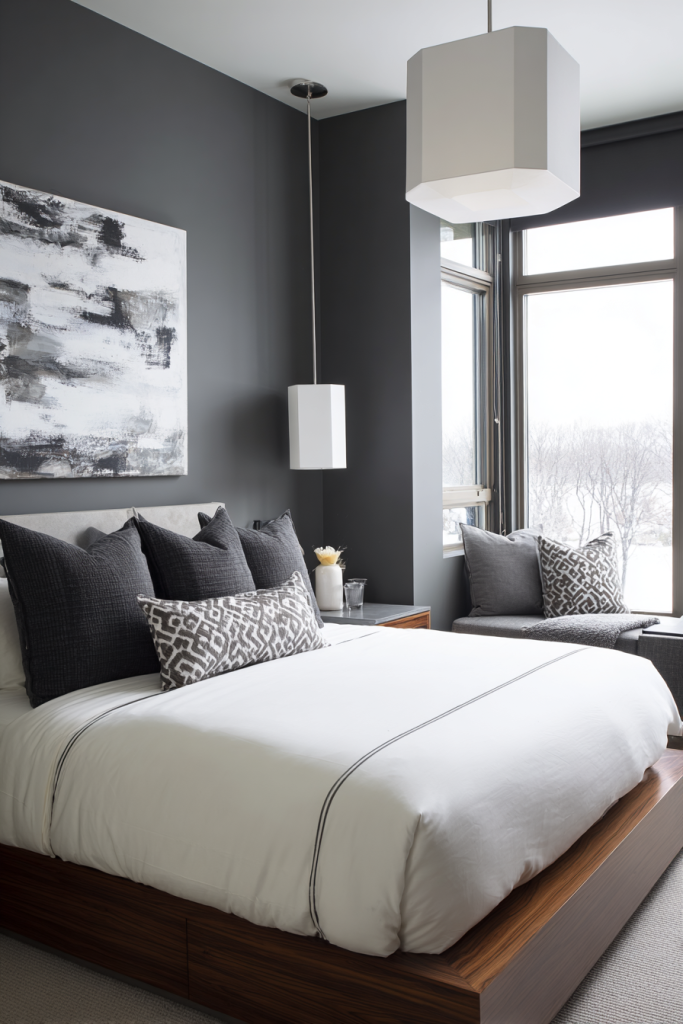
8. Dreamy Pale Lavender
Pale lavender creates a dreamy, ethereal atmosphere that promotes relaxation and peaceful sleep. This gentle purple hue offers just enough color to feel special without overwhelming your senses.
Lavender has long been associated with calmness and stress relief—the color carries the same soothing properties as the scent. It creates a feminine, romantic space that feels like sleeping in a cloud.
Keep the rest of your decor soft and light to maintain the dreamy quality. White furniture, flowing curtains, and plush textiles in cream and soft gray complement lavender beautifully. Add sparkle with crystal or mercury glass accents for a touch of glamour.
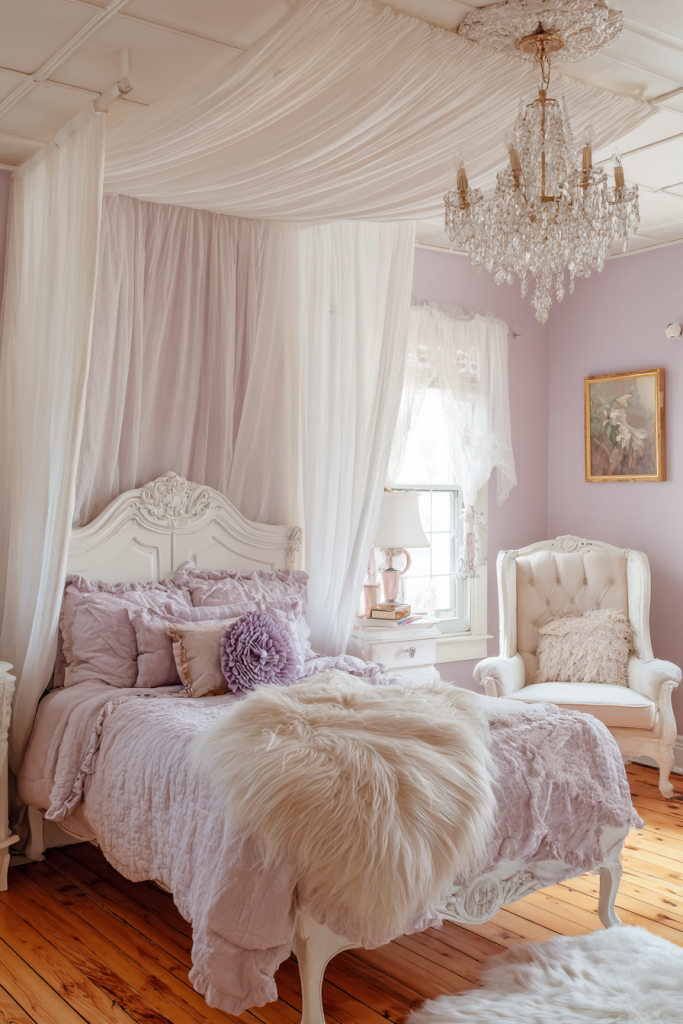
9. Warm Terracotta
Terracotta brings earthy warmth and bohemian charm to your bedroom, evoking the sun-baked beauty of Mediterranean landscapes. This clay-inspired hue creates an instantly cozy, inviting atmosphere that feels both grounded and adventurous.
The rich, warm undertones of terracotta work particularly well in rooms with plenty of natural light. It pairs beautifully with natural materials like woven baskets, leather accents, and carved wood furniture, creating an organic, lived-in feel.
Balance the intensity by incorporating plenty of cream, ivory, and natural linen textiles. Add pops of sage green or dusty blue for a more complex, layered color story. Terracotta also looks stunning with black iron hardware and light fixtures.
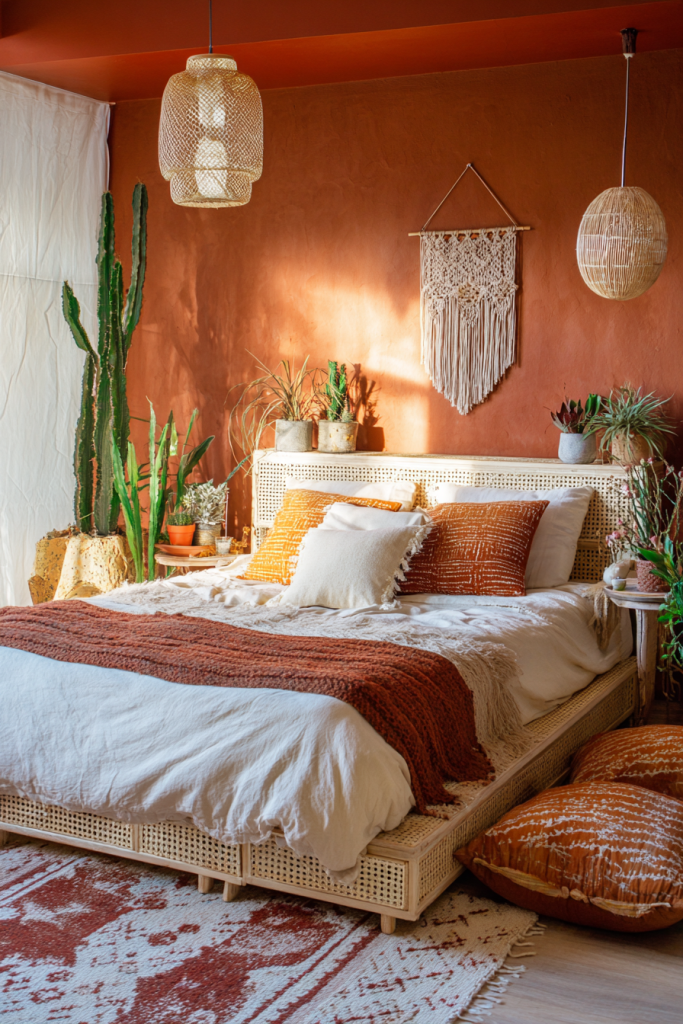
10. Energizing Mustard Yellow
Mustard yellow strikes the perfect balance between cheerful energy and sophisticated warmth. This golden hue brings sunshine into your bedroom without the harshness of bright yellow, creating an optimistic yet restful space.
Yellow stimulates creativity and happiness while the muted mustard tone keeps it from being overpowering. It works exceptionally well in bedrooms that don’t receive much natural light, instantly brightening and warming the space.
Pair mustard with charcoal gray or navy blue for a striking contrast. White and natural wood tones also complement it beautifully. Keep bedding neutral to prevent visual overwhelm, and add pattern through accent pillows or artwork.
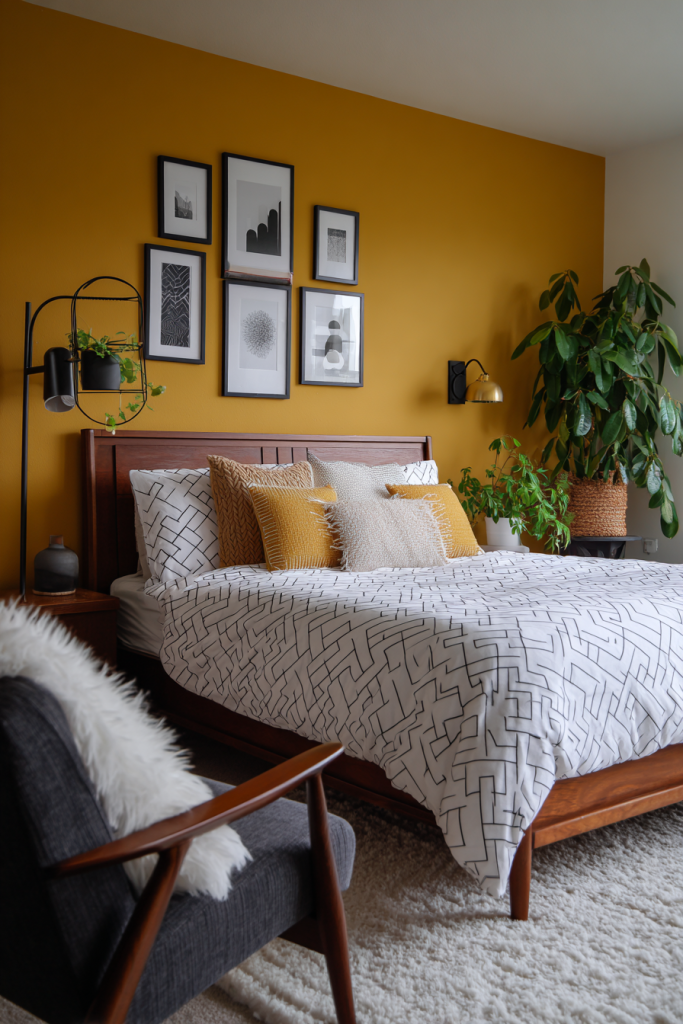
11. Timeless Creamy Ivory
Creamy ivory offers all the brightness of white with added warmth that prevents the sterile feeling. This versatile neutral creates a soft, welcoming backdrop that works with absolutely any decor style or color accent.
The subtle warmth of ivory makes your bedroom feel inviting rather than clinical. It reflects light beautifully while adding just enough color to create depth and interest. Ivory also has the magical quality of making small spaces feel larger.
Layer different shades of white, cream, and ivory through your bedding and textiles for a monochromatic look with depth. Add interest through varied textures—think velvet, linen, wool, and silk. Introduce color through artwork, plants, or decorative accessories.

12. Luxurious Deep Burgundy
Deep burgundy makes a bold statement, bringing opulence and drama to the bedroom. This rich wine color creates an intimate, cocoon-like atmosphere that feels both romantic and sophisticated.
Burgundy works best when you commit fully—either paint all walls for a wrapped, enveloping effect, or create a stunning accent wall behind your bed. The depth of color adds incredible richness and makes metallic accents truly shine.
Balance the intensity with plenty of cream, ivory, or soft gold textiles. Velvet and silk fabrics complement burgundy beautifully, enhancing the luxurious feel. Add warmth through brass or gold light fixtures and hardware.

13. Modern Pale Gray
Pale gray creates a contemporary, minimalist foundation that lets your furniture and decor shine. This light neutral offers more depth than white while maintaining the same bright, airy quality.
The beauty of pale gray lies in its chameleon-like quality—it takes on different tones depending on your lighting and surrounding colors. In north-facing rooms, it may read cooler; in sunny spaces, it appears warmer and softer.
Pale gray provides the perfect backdrop for a Scandinavian-inspired bedroom. Pair it with light woods, white linens, and minimal black accents for a clean, serene look. Add warmth through natural textures like wool, linen, and sheepskin.
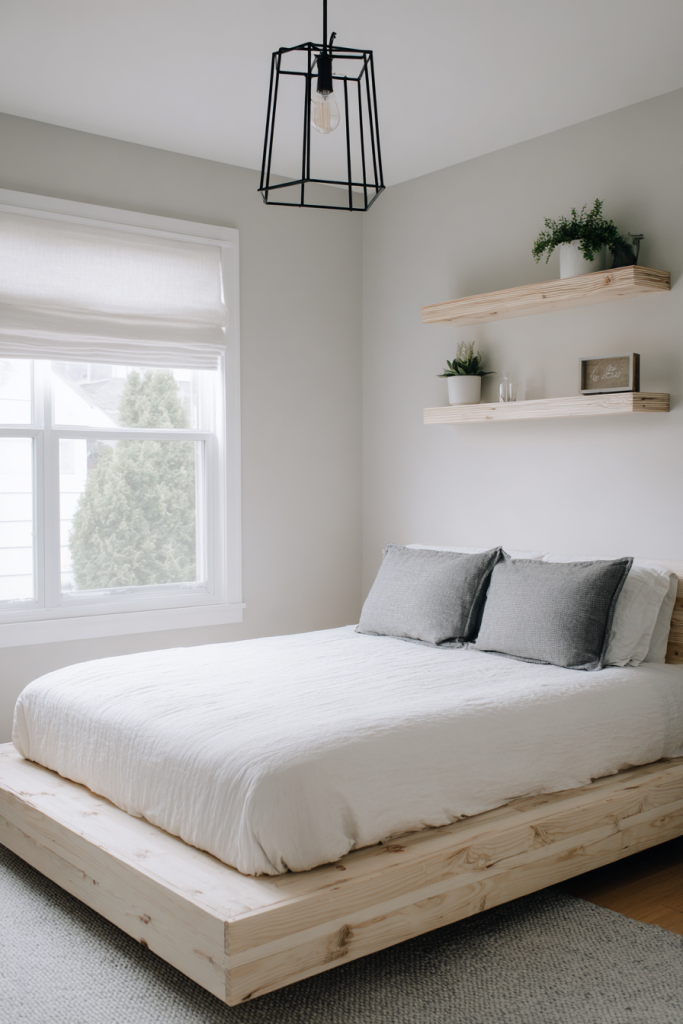
14. Grounding Olive Green
Olive green creates a sophisticated, nature-inspired retreat that feels both modern and timeless. This muted green tone brings the calming properties of nature indoors while maintaining a refined, elevated aesthetic.
Olive works beautifully with warm wood tones and natural materials, creating an organic, harmonious space. It’s deeper than sage but not as bright as emerald, sitting in that perfect middle ground of richness and subtlety.
Pair olive green with cream, tan, and warm browns for an earthy palette. Add black accents for contrast and definition. Natural fiber rugs, leather furniture, and brass hardware complement olive green perfectly.
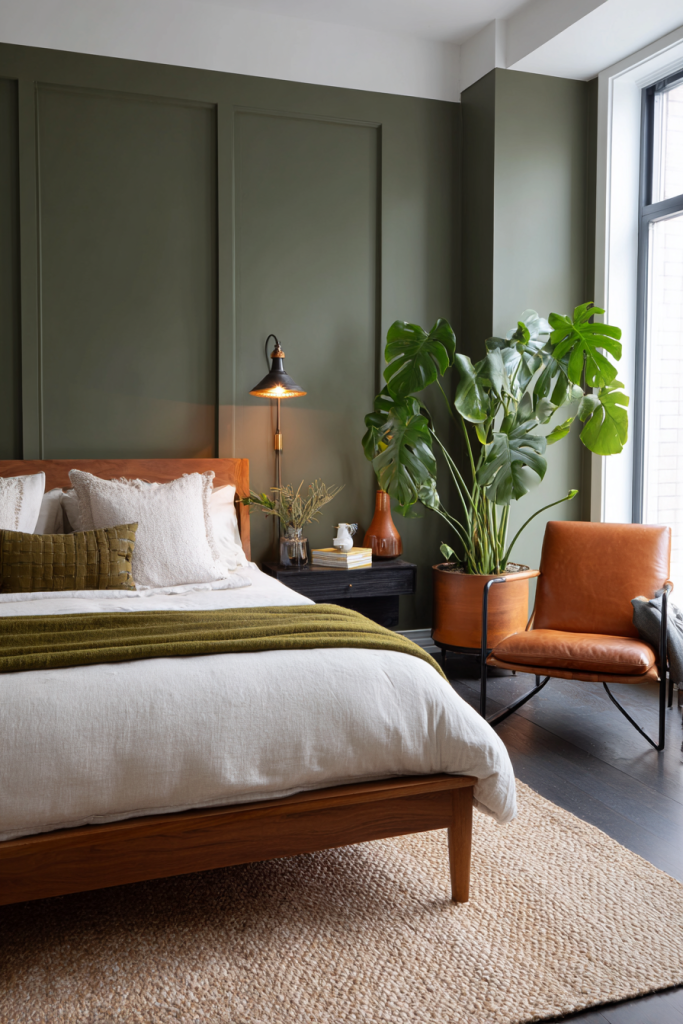
15. Dramatic Black Accent Wall
For the bold and fearless, a black accent wall creates instant drama and modern edge. While painting an entire bedroom black might feel overwhelming, a single statement wall transforms the space completely.
Black provides the ultimate contrast, making white bedding pop and colors appear more vibrant. It adds depth and sophistication, creating a gallery-like atmosphere for showcasing artwork or decorative elements.
Keep the remaining walls light—white, cream, or soft gray—to maintain balance. Use plenty of light sources including table lamps, wall sconces, and overhead lighting. Metallic accents in brass or copper add warmth against the black.
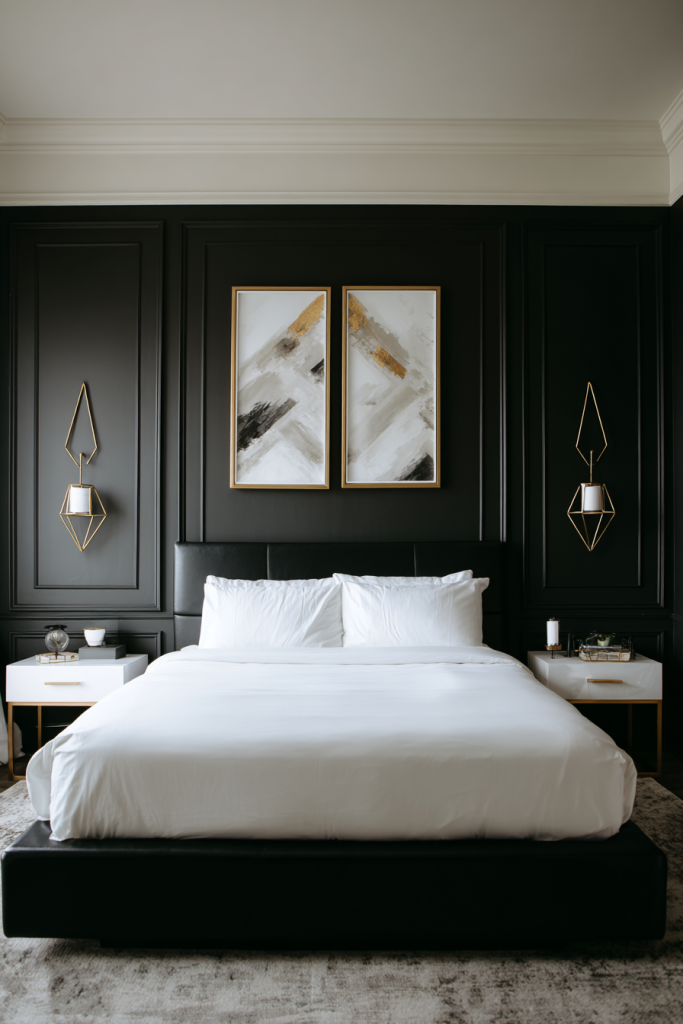
CONCLUSION
The transformative power of paint never ceases to amaze me. With just a few gallons and a weekend of work, you can completely reimagine your bedroom’s atmosphere. Whether you’re drawn to soothing neutrals that promote deep sleep, nature-inspired greens that ground your space, or bold statement colors that showcase your personality, the perfect shade is waiting for you.
Remember, there’s no universal “right” color—only the right color for you and your space. Consider your room’s natural lighting, the mood you want to create, and how the color makes you feel. Don’t be afraid to test samples on your walls and live with them for a few days before making your final decision.
Your bedroom should be your favorite room in the house, a personal sanctuary that reflects who you are while providing the rest and rejuvenation you need. The colors you choose play a crucial role in creating that perfect retreat.
Ready to transform your bedroom? Pick your favorite shade from this list and start planning your makeover today. Trust me, you’ll wonder why you waited so long to make the change!
FAQ SECTION
What’s the best paint finish for bedroom walls?
For bedroom walls, I always recommend eggshell or satin finish. These provide a subtle sheen that’s easy to clean while hiding minor wall imperfections. Matte finishes work beautifully for a modern look but show scuffs more easily. Avoid high-gloss finishes in bedrooms as they can be too reflective and stimulating for a restful space.
How do I choose between warm and cool paint colors?
Consider your room’s natural lighting first. North-facing rooms benefit from warm colors (beiges, creams, warm grays) to counteract cool natural light. South-facing rooms can handle cooler tones beautifully. Also think about the mood you want—warm colors feel cozy and intimate, while cool colors create calm and spacious feelings.
Should I paint all walls the same color or create an accent wall?
Painting all walls the same color creates a cohesive, wrapped feeling that makes rooms appear larger. Accent walls work wonderfully when you want to highlight architectural features or create a focal point behind your bed. For bolder colors like navy or black, an accent wall lets you experiment without overwhelming the space.
How many paint samples should I test before deciding?
I recommend testing at least three to five samples. Paint large swatches (at least 2′ x 2′) on different walls to see how the color looks in various lighting throughout the day. Live with the samples for at least 48 hours, observing them in morning light, afternoon sun, and evening artificial light before making your final choice.

